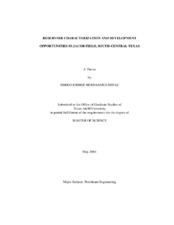| dc.description.abstract | The Jacob field was discovered in the year 1931. In the year 2002, due to the low productivity of the field, the company wanted to determine whether to keep operating, abandon or sell the field. So they asked Texas A&M University to perform the study, determine the oil potential, and make recommendations to improve production. Since no previous reservoir study was performed in this field, the original oil in place and the current status of depletion was unknown. Therefore a complete integrated study was needed in order to learn about the reservoir and evaluate it in a qualitative and quantitative manner, before making any recommendation. The current pay zone underlying the Jacob field forms a monocline structure composed of unconsolidated young clastic sediments deposited in the Eocene epoch of the stratigraphic column of the Nueces River Basin, mainly due to a fluvial deltaic system developed in south Texas. The original oil in place for this pay zone was estimated to be 18.12 MMSTB and the cumulative production as of October 2003, 3.8 MMSTB. The analysis of the production data available had shown that the pay zone is being flooded by a strong water encroachment from the lower sides of the structure. This behavior was confirmed by the anisotropy analysis from core and log data, which shows that the reservoir tends to be more homogeneous in the direction of the water encroachment. It seems that there is not much room for further development in the current pay zone in the Jacob field (the remaining reserves were estimated to be 10 MSTB as of October 2003). However, the presence of a continuous shallow clean sandstone, not properly tested, of better reservoir properties than the actual pay zone was noticed. Moreover, this clean sandstone showed oil and gas presence in thirteen wells in the drilling cuttings. Therefore further development should concentrate more on investigating and developing the oil potential of the latter sandstone as well as accelerating the reserves production in the actual pay zone by means of waterflooding and/or infill drilling. | en |


